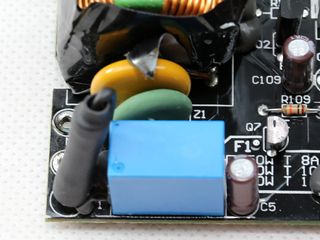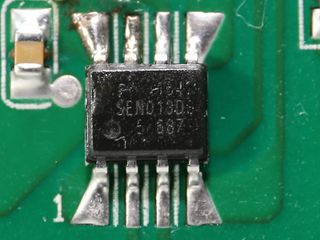FSP Hydro PTM 750W PSU Review
Why you can trust Tom's Hardware
Teardown & Component Analysis
Parts Description
Before proceeding with this page we strongly encourage you to a look at our PSUs 101 article, which provides valuable information about PSUs and their operation, allowing you to better understand the components we're about to discuss. Our main tools for disassembling PSUs are a Thermaltronics soldering and rework station and a Hakko FR-300 desoldering gun. Finally, for the identification of tiny parts we use an Andonstar HDMI digital microscope.
| General Data | |
|---|---|
| Manufacturer (OEM) | FSP |
| Platform Model | PTM |
| Primary Side | |
| Transient Filter | 4x Y caps, 2x X caps, 2x CM chokes, 1x MOV |
| Inrush Protection | NTC thermistor & relay |
| Bridge Rectifier(s) | 1x GBJ2506 (600V, 25A @ 100°C) |
| APFC Disconnect IC | Power Integrations SEN013DG |
| APFC MOSFETs | 3x Toshiba TK20A60W (600V, 20A @ 150°C, 0.13Ω) |
| APFC Boost Diode | 1x CREE C3D06060A (600V, 6A @ 154°C) |
| Hold-up Cap(s) | 2x Rubycon MXH (420V, 330uF each or 660uF combined, 2000h @ 105°C) |
| Main Switchers | 2x STMicroelectronics STFI26NM60N (600V, 12.6A @ 100°C, 0.165Ω) |
| Driver IC | 1x Silicon Labs Si8233BD |
| APFC Controller | Infineon ICE2PCS02 Supporting IC: Fairchild KA393 |
| Resonant Controller | Champion CM6901T2X |
| Topology | Primary side: Half-Bridge & LLC Resonant Controller Secondary side: Synchronous Rectification & DC-DC converters |
| Secondary Side | |
| +12V MOSFETs | 4x Toshiba TPHR85 04PL (SOP Advance Series, 40V, 150A @ 25°C, 0.85 mΩ ) |
| 5V & 3.3V | DC-DC Converters: 6x Infineon BSC0901NS (30V, 94A @ 100°C, 1.9mΩ) PWM Controller: ANPEC APW7159C |
| Filtering Capacitors | Electrolytics: 6x Chemi-Con KZE (1000 to 5000h @ 105°C), 2x Chemi-Con KY (4000 to 10,000h @ 105°C), 7x Rubycon ZLH (6000 to 10,000h @ 105°C) Polymers: Teapo (Taiwan) |
| Supervisor IC | SITI PS223 (OCP, OTP, OVP, UVP, SCP, PG) |
| Fan Model | Protechnic Electric MGA13512XF-A25 (135mm, 12V, 0.38A, FDB) |
| 5VSB Circuit | |
| Rectifier | International Rectifier IRFR1018E (60V, 56A @ 100°C, 8.4 mΩ) |
| Standby PWM Controller | Power Integrations SC1225K |





This platform is an updated version of the one used in FSP's Hydro G 750. There are some component changes, and some circuits are relocated on the PCB in an effort to enhance the HPT750M's performance, though. A half bridge topology is utilized on the primary side, along with an LLC resonant converter. On the secondary side, we find a synchronous design and a couple of DC-DC converters for generating the minor rails. All of the electrolytic filtering caps, along with the ones used by the APFC converter, are provided by top Japanese manufacturers. The polymer caps come from Teapo, a highly-regarded Taiwanese company.
We only find a couple of small heat sinks on the secondary side, since the +12V FETs are mostly cooled by the PSU's chassis. This is a common technique in modern PSUs. It saves space, allowing for a smaller PCB and more filtering caps for better ripple suppression.




The PCB behind the AC receptacle holds two Y caps, and a single X cap is also connected to it. The EMI filter continues on the main PCB with two more Y caps and an additional X cap, two CM chokes, and an MOV. The filter looks to be complete; however, the platform's conducted EMI noise is higher than we expected.

Inrush-current protection is handled by an NTC thermistor. A bypass relay allows it to cool down faster.

The single bridge rectifier (GBJ2506) can handle up to 25A of current, making it strong enough to support this platform.

Under the PFC choke, on the solder side of the PCB, there's a Power Integrations SEN013DG IC responsible for disconnecting the PFC converter when the PSU is in standby mode, limiting energy losses.




The APFC converter uses three Toshiba TK20A60W FETs and a single CREE C3D06060A boost diode. A pair of bulk caps is provided by Rubycon, and their combined capacity is 660uF. This might look low for a 750W PSU, but the HPT750M still achieves a pretty high hold-up time.


A small board holds the APFC controller, an Infineon ICE2PCS02 IC. We find one more IC at the front: a Fairchild KA393 dual differential comparator.


A Power Integrations SC1226K serves as the 5VSB circuit's PWM controller, and the FET that regulates the rail is an International Rectifier IRFR1018E. What results is one of the most efficient 5VSB rails we've ever measured.


Two STMicroelectronics STFI26NM60Ns are the main switching FETs. They are driven by a Silicon Labs Si8233BD.


The +12V FETs, four Toshiba TPHR8504PLs, are on the PCB's solder side. Heat generated by them is dissipated through a pad attached to the PSU's enclosure. On top of the PCB, a couple of small heat sinks also help. As you can see in the album above, the TPHR8504PL FETs don't look like ordinary ones since they have eight pins instead of three.


A board right behind the modular PCB hosts the LLC resonant controller, a Champion CM6901.





The electrolytic filtering capacitors come from Chemi-Con's KZE and KY families. We also find a few Rubycon electrolytic caps. They're all rated for 105°C and should last a long time. Although the polymer caps aren't made by a Japanese company, they are manufactured by Teapo, a respected Taiwanese supplier. And since polymer caps last much longer than electrolytic ones at very high temperatures without a problem, we have nothing to complain about.




A vertical board hosts both DC-DC converters used to generate the minor rails. The common PWM controller is an Anpec APW7159C, and a total of six Infineon BSC0901NS FETs are used by both rails.


Another vertical board houses the protections IC, a SITI PS223. This is one of the few ICs with over-temperature protection support right out of the box.





On the modular PCB's front side, several Teapo polymer caps and a couple of electrolytic Chemi-Con caps filter the rails. A number of bus-bars at the bottom of this board connect it to the main PCB, minimizing the amount of power wasted during transfers, especially under higher loads.







FSP's soldering quality is good, though surely not top-notch. We also found some of those long component leads that we hate to see; they can be the cause of dangerous shorts.


The cooling fan is by Protechnic Electric and its model number is MGA13512XF-A25. This is a fluid dynamic bearing-based fan controlled by a rather loose profile. Output noise should remain pretty low.
MORE: Best Power Supplies
MORE: How We Test Power Supplies
MORE: All Power Supply Content
Current page: Teardown & Component Analysis
Prev Page Packaging, Contents, Exterior & Cabling Next Page Load Regulation, Hold-Up Time & Inrush CurrentStay On the Cutting Edge: Get the Tom's Hardware Newsletter
Get Tom's Hardware's best news and in-depth reviews, straight to your inbox.

Aris Mpitziopoulos is a contributing editor at Tom's Hardware, covering PSUs.

Chinese mineral restrictions spur Australia to scavenge waste for new sources of chipmaking materials — country turns to mining waste for rare earths

Supermicro's stock plummets 35% in one day as accounting firm resigns — storm brews after DOJ probe into manipulated finances

Intel Core Ultra 9 285K cooling testing: How much does it take to keep Arrow Lake cool in MSI's MPG Gungnir 300R Airflow PC Case?